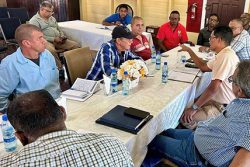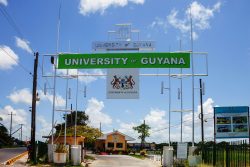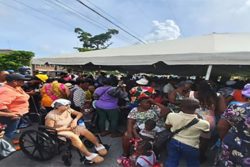On July 7th the body of Evelyn Alfonzo Alves was found at Diamond, East Bank Demerara with a bullet to the head, the type of execution-style killing that raises all kinds of questions.
She leaves behind three young children to an uncertain fate. One would hope that child care and child protection agencies and NGOs have taken note and will act.
Several days later, Haslyn Hodge, 47, of Lot 43 Prospect, East Bank Demerara was charged with the murder of Ms Alves. This was good work by the police presumably utilizing the network of CCTV cameras that have been established in all parts of the city.
It transpires that Mr Hodge had been previously charged with the murder of his wife and had been acquitted in 2012. Justice Navindra Singh had found that there was insufficient evidence in the case and the jury was asked to return a formal verdict of not guilty. Hodge, then 31, had pleaded not guilty in 2008 to killing Tamasha Riddle, of 126 First Field, Kaneville. Ms Riddle was found dead on her bed with a pillow on her face and it was later determined that she died as a result of asphyxiation.
Presumably there was no eyewitness in the case of the killing of Ms Riddle and that eventuated in an acquittal. In the case of Ms Alves there does not appear to have been a witness to the killing. Even if camera footage is available that puts the shooter in proximity to the area in which Ms Alves was killed that might not prove to be the cinch.
This situation raises the question of forensic evidence in the construction of these cases. Where it is clear that only circumstantial evidence is available, the public has to be confident that the police are utilizing the broad spectrum of tools available.
For sometime now, questions have been asked about the diligence with which the police are gathering DNA evidence from crime scenes if at all. In this case, there are a number of points of contact which could possibly establish a nexus with the shooter. DNA samples should have been taken from Ms Alves to determine whether there had been any contact particularly with the accused. DNA samples could also be secured from Mr Hodge and there are any number of points at which DNA evidence could place the victim in the vehicle of the accused.
There has been no public discussion by the police of the type of evidence retrieved and this will probably have to await a paper committal as catered for by recently passed legislation. It would be unfortunate if advantage isn’t taken of all of the available opportunities to develop credible evidence.
On April 30th this year, the police force took possession of a Mercedes Benz crime scene vehicle. The police had said then that one of the major setbacks had been their inability to transport equipment essential for forensic analysis, such as delicate material like blood and DNA samples. This vehicle would therefore have been transformative. It also came equipped with a photographic studio for capturing critical evidence on-site. The lack of mobility, the police said, had hindered the ability to conduct thorough investigations at crime scenes, often resulting in delays and incomplete data collection.
With the introduction of the new Crime Scene vehicle, the police said that these limitations had been effectively addressed. A release from the force had added that the vehicle included a range of amenities designed to facilitate efficient and comprehensive crime scene processing. These included cool storage units for transporting delicate samples to first aid kits and wash sinks aiding in fingerprint processing. The vehicle was described as being outfitted with everything needed to conduct sophisticated forensic analysis on-site. There is therefore no reason to have prevented the police from doing a thorough investigation in this matter and then properly presenting the evidence to the court.
There is also the allied question of DNA testing. There have long been issues with the output from the expensive Guyana Forensic Science Laboratory. In January this year, Minister of Home Affairs Robeson Benn said that while the DNA analysis workflow system was almost fully operational, some samples were still being sent overseas for analysis.
Responding to a question at his ministry’s end-of-year press conference, he said, “There are particular ones, and depending too on the quality and speed of return which we have sent overseas. I think we are waiting on particular instrumentation to make that even faster.”
Asked about the functionality of the system so far, Mr Benn assured reporters that efforts were being made to improve the speed and quality of DNA testing.
“We should be having a visit shortly to [a] regional laboratory in respect of their procedures and methodologies in respect of the forensic laboratory. We have had four experts recently employed. These are doctorates and masters [with] specialisations in terms of supporting work at the forensic laboratory and they are already working with us and we are seeing improvements in the backlog which we have had…,” Mr Benn said.
The public hopes that significant progress has been made in this regard.
On November 19 last year, a 48-year-old West Coast Berbice woman, Daniele Charles was murdered after meeting at a bar with some friends. According to the police, the naked body of Ms Charles was found in a clump of bushes. A multi-coloured top with suspected bloodstains, three-quarter pants, bra and underwear were found next to the body, along with a used condom and wrapper.
It was found that she had been stabbed ten times; six to the abdomen, once to the left side breast, twice to the throat and once to the centre of the chest. Thus far, no charge has been brought in this matter. Had the full range of forensic investigations been applied in this case it might have been elucidated. The case of Ms Alves will establish whether the police are making significant improvements in the gathering of forensic evidence.









